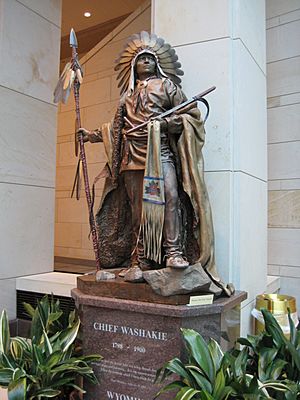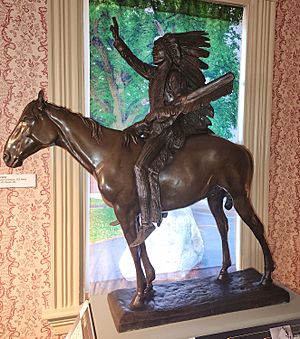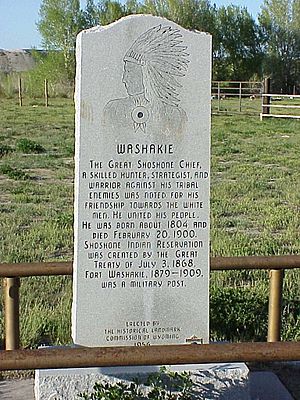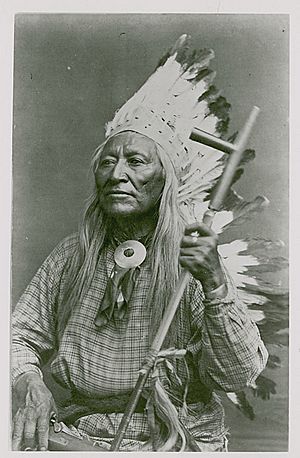Washakie facts for kids
Washakie (born around 1804-1810 – died February 20, 1900) was a very important leader of the Shoshone people in the mid-1800s. People first wrote about him in 1840. From 1851 until he died, the United States government saw him as the main leader of the Eastern Shoshones. In 1979, he was honored in the Hall of Great Westerners at the National Cowboy & Western Heritage Museum.
Contents
Who Was Washakie?
Washakie's Early Life and Family
We don't know everything about Washakie's early life, but we do have some details. He was born between 1798 and 1810. His mother, Lost Woman, was a Tussawehee (White Knife) Shoshone. His father, Crooked Leg, was from the Umatilla tribe. He was adopted into a Shoshone clan.
Washakie's birth name was Pinaquanah, which means "Smells of Sugar." As a teenager, he changed his name to Shoots the Buffalo Running. He was also known as Gourd Rattler because he was good at a gambling game using a gourd rattle.
Washakie met his first white men in 1811. They were part of a fur trading group. His father, Crooked Leg, was killed in 1824 by members of the Piegan Blackfeet tribe. This happened during a raid on a Shoshone hunting camp.
Washakie's Role as a Leader
By the late 1800s, Washakie became the head chief of the Eastern Shoshone. He was the only Shoshone warrior honored by the federal government of the United States. He helped General George Crook's army defeat the Sioux after Lieutenant Colonel George Armstrong Custer's loss at the Little Big Horn.
The exact year Washakie was born is still discussed. Some records say 1798, but his tombstone says 1804. He once told an agent that he met Jim Bridger when he was 16. Researchers think he was likely born between 1808 and 1810.
His name, "Washakie," is thought to describe his battle tactics. One story says he used a large rattle made from buffalo hide to scare enemy horses. This earned him the name "The Rattle" or "Gourd Rattler." Another meaning for "Washakie" is "Shoots-on-the-Run."
Washakie's Bravery in Battle
Fur trappers in the 1830s wrote that the Blackfeet tribe feared Washakie. He had a scar on his cheek from an enemy arrow he got during a raid.
In 1866, Washakie fought a one-on-one battle with Crow Chief Big Robber. This fight was to decide who had rights to the Wind River Basin. Washakie won and showed his enemy's heart on a spear. This event is remembered in the name Crowheart Butte on the Wind River Indian Reservation. A sculpture of this event was put up in 2005 at the University of Wyoming.
Washakie and the Fur Trade

Washakie's group took part in the fur trade meetings, called rendezvous, from 1825 to 1840. These meetings happened in areas where the Shoshone and Bannock tribes lived. Washakie said he and Jim Bridger became close friends. Bridger even married Washakie's daughter in 1850.
Washakie learned some French and English from the trappers and traders. His strong connection with the trappers helped him build a good relationship with U.S. officials later on.
Treaties and Land for His People
Washakie signed treaties with the U.S. government at Fort Bridger, Wyoming, in 1863 and 1868. The 1863 treaty set up a large area of land for the Shoshone.
The 1868 treaty was even more important. It created the Shoshone and Bannock Indian Agency in Wyoming. This land was chosen by Washakie and his leaders. The first reservation was about 3 million acres (12,000 km²) in the Wind River area. Even though some land was later given up, this valley is still home to the Eastern Shoshones today. Washakie also wanted Native Americans to get an education. He gave land for a boarding school where Shoshone girls learned traditional crafts and their language.
Washakie's Faith
Washakie and Mormonism

Washakie was a friend of Brigham Young, a leader of the Church of Jesus Christ of Latter-day Saints. After Young's death, Washakie joined the church. He was baptized on September 25, 1880. About 300 other Shoshone people also joined the church at that time.
Washakie and Episcopalianism

In 1883, the Episcopal Church sent John Roberts to work with the Shoshone and Arapaho people on the Wind River Reservation. Roberts built several churches.
Washakie's son was killed by a white man in 1885. Some say Washakie wanted revenge, but Roberts offered his own life instead, earning the Chief's respect. Roberts learned Shoshone customs and language. He even translated the Bible into Shoshone. Around 1888, Washakie helped Roberts start a boarding school for Shoshone girls. He donated 160 acres (0.65 km²) of land for it.
Washakie chose Episcopalianism as his faith. He was baptized again in 1897. When he died in 1900, his friend Roberts led his funeral service.
Honoring Washakie

Washakie was known for his bravery in battle, his efforts for peace, and his dedication to his people. This made him one of the most respected Native American leaders. In 1878, a U.S. Army outpost on the reservation was renamed Fort Washakie. This was the only U.S. military outpost named after a Native American. When he died in 1900, he was given a full military funeral, which was very rare for a Native American leader.
Washakie County, Wyoming is named after him. There is also a statue of his head in front of the Washakie County Courthouse. In 2000, Wyoming gave a bronze statue of Washakie to the National Statuary Hall Collection. You can also find a statue of Washakie in downtown Casper, Wyoming. The dining hall at the University of Wyoming is named after him, too. The town of Washakie, Utah was also named in his honor.
During World War II, a ship called SS Chief Washakie was named after him. A U.S. Navy tugboat, USS Washakie, was also named for him.
Washakie was also an artist who painted on animal hides. An elk hide painting from 1880, showing the Sun Dance, is believed to be his work.
Chief Washakie Foundation
The Chief Washakie Foundation was started in 2004. It helps with education programs and research about the history and culture of the Shoshone and Arapaho people in Wyoming. It also supports Native American education. As of April 2013, Washakie's great-great grandson, James Trosper, is the Chair and Executive Director.



